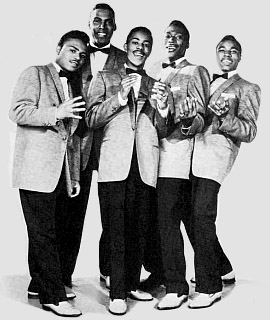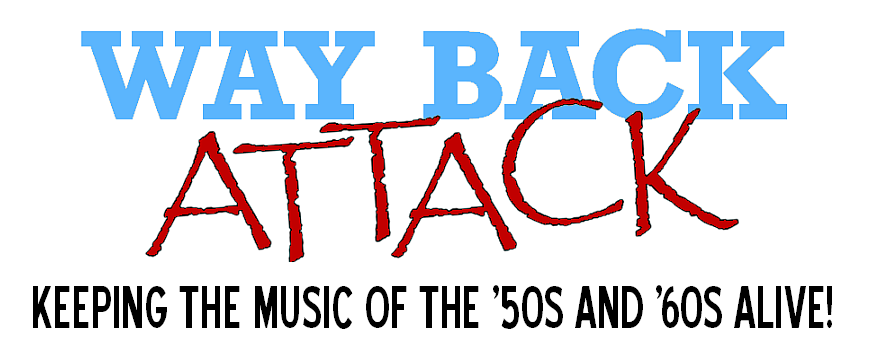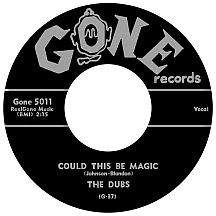THE DUBS
Could This Be Magic
One of the most highly-esteemed vocal groups of the '50s came together in New York's Harlem district by way of three different acts, all of them quintets (barring brief times when a member would depart before another joined). At the time of The Dubs' peak success from 1957 through 1959, the lineup consisted of tenor Cleveland Still, who was well organized and helped keep the group on an even keel during this two-year stretch. Baritone James "Jake" Miller, second tenor Billy Carlisle and bass Tommy Grate were friends with Still from the start. All they needed was the right lead singer; when Still met Richard Blandon, he immediately recognized his expressive, unwavering delivery and before long they had a unanimous choice for lead singer.
Their history can be traced to the formation of The Five Wings, with Carlisle and Grate, around 1954. Other members were Frank Edwards, Melvin Flood and lead singer Jackie Rue; their manager was Hiram Johnson (hitmaking bandleader Buddy Johnson's brother), who would later start his own Johnson record label. After signing with King Records, the best-known Five Wings release was "Johnny's Still Singing" and "Johnny Has Gone," a two-sided early '56 homage to abruptly-departed star Johnny Ace (whose tendency to play with guns went awry the previous Christmas). Another King disc, "Teardrops Are Falling," reveals (as the Ace tributes had) a penchant for ballads, which would serve the Five Wings well during the evolving act's most successful phase.
Another group, The Scale-Tones, included Jake Miller among its ranks and, later, Cleveland Still. One Scale-Tones single, the uptempo "Dreamin' and Dreamin'," appeared on the Jay-Dee label in early '56, though by the autumn of that year they were close to calling it quits. The Five Wings, who'd dwindled to just Blandon and Carlisle, had a chance meeting with the Scale-Tones. Still wasted no time in convincing them to start yet another group, The Marvels, with Miller and Grate. "Jump Rock and Roll" (the title an accurate description of its sound) was the A side of The Marvels' only single on ABC-Paramount. Then they made an arrangement with Hiram Johnson; in early 1957 the quartet recorded a song for the new, eponymous Johnson label.
Changing their name once again to the Dubs (inspired by the slang term for committing a session tape to disc), Cleveland, Jake, Tommy, Billy and main vocal draw Richard Blandon locked in as the lineup responsible for all the Dubs' hit singles over the next two years. The lyrics of "Don't Ask Me to Be Lonely," penned by Blandon (with Johnson also taking credit), coaxed a love interest by asking for anything (the world, the moon, the stars, even diamonds!)...except, that is, the dreaded isolation of being left alone. The dynamic ballad caught on, but pressings on Johnson couldn't be made fast enough to meet demand, so Hiram made an arrangement with Gone Records head George Goldner for nationwide distribution. It was popular in New York City, spending two months in WMGM's top 40 while breaking in several other markets, resulting in four weeks on Billboard's Top 100, culminating in a weeklong engagement at the Apollo Theater with the summer of '57's hottest R&B acts.
Keeping with the ballad approach, the session for the Dubs' biggest hit utilized some of N.Y.'s top musicians including guitarist Mickey Baker and sax man Buddy Lucas. "Could This Be Magic" (another composition by lead vocalist Blandon) took off later that summer, its unabashed romanticism ('...my heart's all aglow...') connecting on a larger scale, reaching the top ten on more than a dozen radio stations in major markets. It hit number 23 on Billboard and was followed by an expanded touring schedule including a headlining engagement at the Apollo in November. Its early '58 follow-up, "Beside My Love" (written by Johnson and former Scale-Tones bass vocalist Thomas Gardner), was oddly issued on both Gone and End (another of Goldner's many labels).

"Be Sure (My Love)," another yearning love song and fan favorite composed by Richard Barrett and Stuart Wiener, made its best showings in New York and Pittsburgh and was followed in early 1959 by "Chapel of Dreams," a song by Billy Myles (the singer best known for his 1957 hit "The Joker"), which took several months before impacting the charts for several weeks in August and September. But frustration set in as group members complained of having very little money to show for their two years of prominence. They went their separate ways to work at blue collar jobs with the exception of Blandon, who rejoined The Vocaleers (he'd been in the group a short time in the pre-Dubs days).
They reconsidered their stance as soon as "Chapel of Dreams" began getting support from radio. Blandon felt he'd learned a thing or two about how to better control his fate in the oftentimes brutal recording industy and had little trouble convincing Carlisle, Miller and Grate to get back on board (singing for a living seemed a better gamble than toiling at those low-paying "regular" jobs anyway). A new first tenor, Cordell Brown, filled out the roster. The reconfigured act waxed "I Need Your Love So Bad" for the Paradise label (part of Hy Weiss's Old Town operation). Several ABC-Paramount releases ("No One," "Don't Laugh at Me" and "For the First Time" among some of the songs composed by group members) had limited success between late '59 and '61. In addition, a reissue of "Be Sure (My Love)" on Mark-X Records took advantage of the "doo wop revival" that was giving second chances to earlier vocal group gems; the song received heavy airplay in the early months of 1961 in west coast markets Los Angeles, San Bernardino, Santa Barbara and San Francisco.
Josie Records released an album in 1962, The Dubs Meet the Shells, splitting the selections between the two groups (The Shells' 1957 Johnson disc "Baby Oh Baby" had belatedly become a hit as part of the revival). Sessions with Goldner in 1962 produced the Gone singles "Now That We Broke Up" and "You're Free to Go." A coupling on Wilshire Records made a little noise in 1963: "Your Very First Love" was popular in the west, while "Just You" was popular in the east. Also, Five Wings singer Jackie Rue formed Jackie and the Starlites, putting out several 45s between 1961 and '64 on Fury, Fire, Mascot and Hull.
Not much happened for about a decade until some unreleased Dubs songs ("Connie," "I Won't Have You Breaking My Heart" and others) were reissued by Hiram Johnson - on his Johnson label - in 1973. Richard Blandon kept the group going with several younger members until his death in 1991. By that time, Cleveland Still had formed another act using The Dubs' name...and has kept the group touring, all the way into his nineties, most recently seen in 2025. "Could This Be Magic"? Yes! For music fans it's the best kind!


